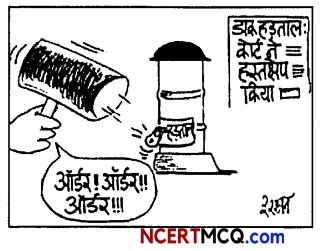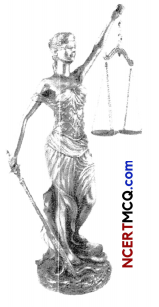Students can access the CBSE Sample Papers for Class 11 Political Science with Solutions and marking scheme Term 2 Set 5 will help students in understanding the difficulty level of the exam.
CBSE Sample Papers for Class 11 Political Science Term 2 Set 5 for Practice
Time: 2 Hours
Maximum Marks: 40
General Instructions:
- The question paper has 3 Sections A, B &C.
- Section A has 8 questions of 2 marks each. Answer to these questions should be completed within 50 words each.
- Section B has 3 questions of 4 marks each. Answer to these questions should be completed within 100 words each.
- Section C has 2 questions of 6 marks each. Answer to these questions should be completed within 170 words each.
Section – A
(2 x 8 = 16)
Question 1.
State the different types of legislature. [2]
OR
State the administrative powers of the Legislative Assembly. [2]
Question 2.
State the similarities between Legislative Assembly and Council of Ministers. [2]
![]()
Question 3.
Define Liberalism. What is the focus of modern liberalism? [2]
Question 4.
Write a short note on negative liberty. [2]
Question 5.
State two of the safeguards that can be put in place to maintain the state of liberty. [2]
Question 6.
Who argued that the root cause of entrenched inequality was ownership of important economic resources such as oil, or land, or forests, as well as other forms of property? [2]
Question 7.
Which inequalities emerge between people as a result of their different capabilities and talents? [2]
![]()
Question 8.
What is known the variations in money, caste, positions of various people? [2]
Section – B
(4 x 3 = 12)
Question 9.
State the powers of the Speaker of Lok Sabha. [3]
Question 10.
Explain in brief how the profiles of the President and Prime Minister are related. [3]
Question 11.
Map Based Question
In the given outline political map of India, four states have been marked as (A), (B), (C) and (D). Identify these states on the basis of the information given below and write their correct names in your answer book along with their respective serial number of the information used and the concerned alphabets as per format that follows: [3]
(i) Student’s Conference held at this place.
(ii) The state to which S. Nijalinagappa belonged.
(iii) In 1979, newspapers published reports about ‘under trials’ reports of Tihar jail is located in this state.
(iv) The state to which the former Prime Minister Morarji Desai was related.

Section – C
(6 x 2 = 12)
Question 12.
Explain the importance of judiciary in a democratic country? [6]
OR
Study the picture given below and answer the questions that follow: [6]

(i) What is depicted in the cartoon?
(ii) What is the information signified in the cartoon?
(iii) What are the various instruments through which judicial activism can be enforced?
(iv) Do you know that in recent times the judiciary has ruled that bandh and hartals of essential goods and services are illegal?
![]()
Question 13.
Study the picture given below and answer the questions that follow: [6]

(i) Why is the statue of justice blindfolded?
(ii) Why is it called that justice delayed is justice denied?
(iii) State one reason for delayed Justice in India.
OR
Discuss measures taken by India to secure social justice? [6]